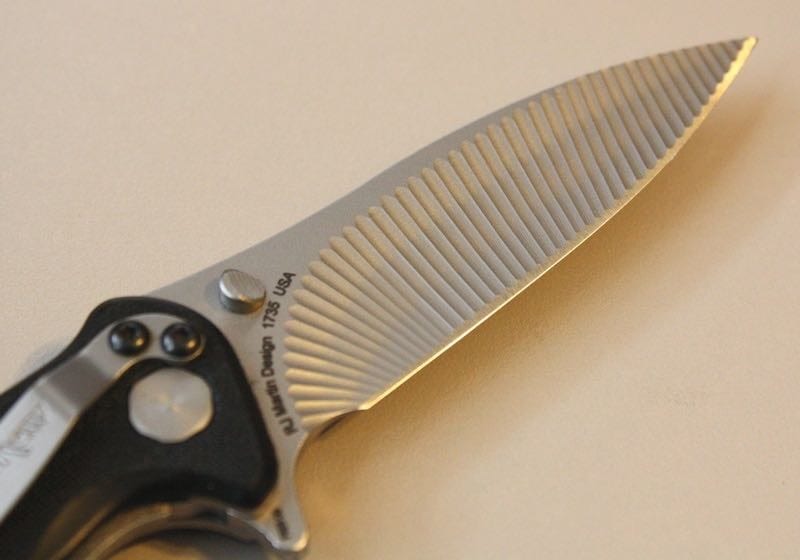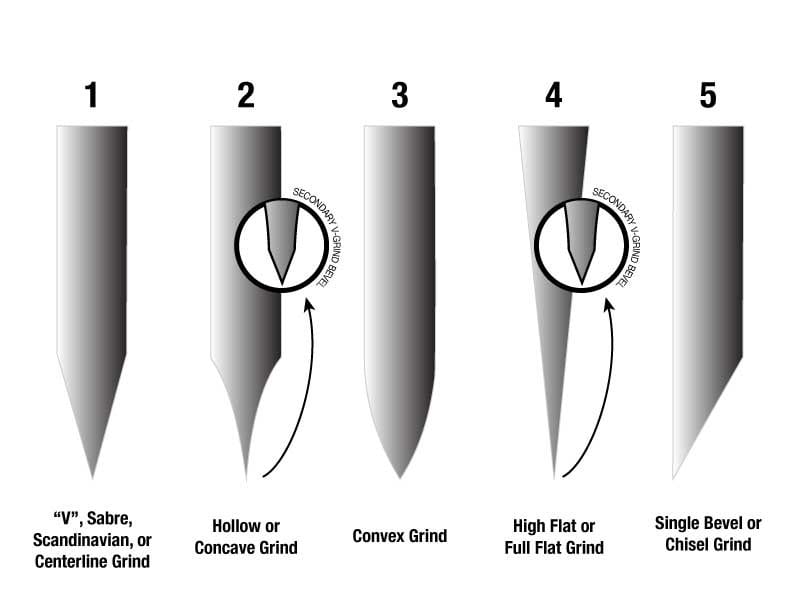Much thought and discussion have gone into the types of blade shapes that various knives possess. Many have their favorites (like the tactical Tanto blade). The way a manufacturer sharpens a blade partially determines how well a blade cuts through any material. More importantly, it also determines how likely it is to retain its sharpness. Knife blade grinds and the steel used in the blade ultimately determine two things. They reveal how sharp the blade can get, and how strong of an edge the knife can hold.
Knife Blade Grinds Table of Contents
1. Sabre Grind, Scandinavian, V Grind, or Centerline Grind
This common knife blade grind allows both the top and bottom bevels to meet perfectly in the middle. The result is a nice center edge that runs the length of the sharpened portion of the blade. The sharpened sides terminate at some midpoint of the blade as opposed to taking up the entire blade to the spine. A centerline knife blade grind produces a nice strong blade grind that you can easily reproduce and sharpen. These V grinds also feature no secondary grind on the edge.
2. Hollow Grind or Concave Grind
A blade with a hollow grind has two concave bevels. These extend either the full width of the blade (full hollow grind) or over a portion of its width. Commonly, hollow grind blades have a secondary V-grind bevel on the edge. A hollow grind creates a blade better suited for filleting and separating thin materials. Use these for skinning or for deboning fish. You might call this the perfect “filet” knife grind.
Editor’s Note: You can refer to any unsharpened, but shaped portion of a blade as a wedge. This reduces blade weight and also produces a nice design aesthetic.

3. Convex Grind
Convex knife blade grinds feature a double-sided convex grind. The bevel is formed by the two continuous curved grinds meeting in the middle. A full convex grind implies that the curve of the grind starts from, and takes up, the entire width of the blade. This type of grind has also been referred to as a Hamamguri, clamshell, Applesee, or Moran grind. You can get this grind by sharpening on a slack leather grinding strap or belt.
4. High Flat Grind or Full Flat Grind
The high flat grind is a flat grind that terminates at the edge. It is similar to a full flat grind except that it leaves some of the flat of the blade near the top. The edge may have a secondary V-grind or convex grind to increase edge strength. As far as knife blade grinds go, the full flat grind is fairly rare. It’s similar to a high flat grind except that it extends a steady bevel all the way through the entire width of the blade (whereas a high flat grind leaves some of the flat of the blade).
5. Single Bevel Grind or Chisel Grind
Like the centerline grind, the is another one of the more popular knife blade grinds. A single bevel grind (sometimes called a chisel grind) resembles one half of a Scandi or high flat grind. One side of the knife remains completely unsharpened while the other side features a flat grind.
The result is a sort of chisel effect. This isn’t so much of a grind on its own so much as it’s a half version of other flat grinds. A single bevel grind may also be made with a single hollow ground edge as well.
Final Thoughts
Hopefully, this article on knife blade grinds helped you at least understand a bit more about the edge on your knife. Some edge grinds produce more cutting power while others deliver better sharpness and edge retention. In the end, you should understand which works for your application. The next decision might include how to put that edge on your own knife or sharpen your own without changing the hone.



